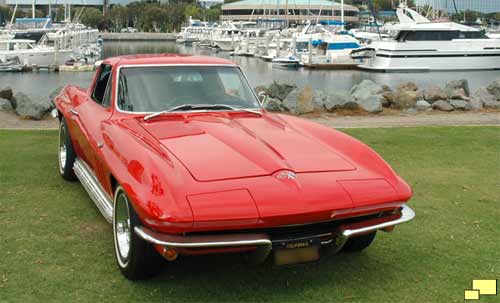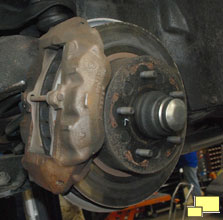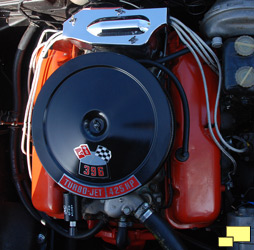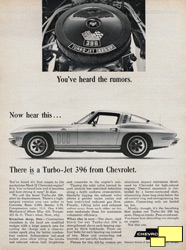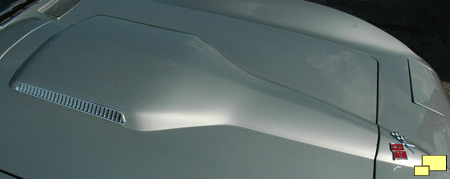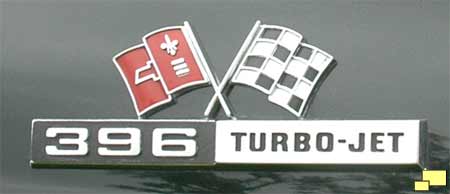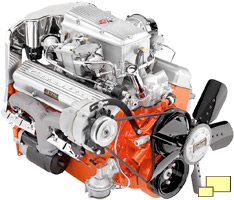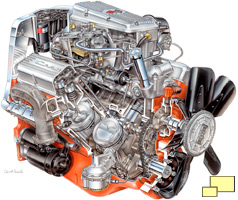Corvette Generations:
C1 C2 C3 C4 C5 C6 C7 C8
Corvette: Year by Year
1953 1954 1955 1956 1957 1958 1959 1960 1961 1962 19631964 1965 1966 1967 1968 1969 1970 1971 1972 1973 1974
1975 1976 1977 1978 1979 1980 1981 1982 1983 1984 1985
1986 1987 1988 1989 1990 1991 1992 1993 1994 1995 1996
1997 1998 1999 2000 2001 2002 2003 2004 2005 2006 2007
2008 2009 2010 2011 2012 2013 2014 2015 2016 2017 2018
2019 2020 2021 2022 2023 2024 2025
Disc Brakes for the Corvette C2 Stingray
The final performance frontier
 1965 is an important year for Corvette. A long desired and needed upgrade - disc brakes - became standard equipment and for years to come would be the only American car so equipped. The good news is that they appeared on all four corners, not just the front as was common practice of the day. Racers were particularly happy with this latest development as they had long been suffering with drum brakes. Although special sintered metallic linings had been available, fade under racing conditions was still a problem. Jaguar had been offering four wheel disc brakes on their more expensive E-Type and it wouldn't do for the Corvette Stingray to be playing second in any area. The unloved drum brakes were still available as a deletion credit (RPO J61, -$64.50) and 316 1965 Corvette Stingrays were so equipped.
1965 is an important year for Corvette. A long desired and needed upgrade - disc brakes - became standard equipment and for years to come would be the only American car so equipped. The good news is that they appeared on all four corners, not just the front as was common practice of the day. Racers were particularly happy with this latest development as they had long been suffering with drum brakes. Although special sintered metallic linings had been available, fade under racing conditions was still a problem. Jaguar had been offering four wheel disc brakes on their more expensive E-Type and it wouldn't do for the Corvette Stingray to be playing second in any area. The unloved drum brakes were still available as a deletion credit (RPO J61, -$64.50) and 316 1965 Corvette Stingrays were so equipped.
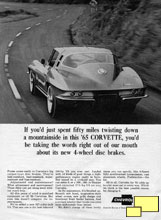
Above left is the front Corvette C2 disk brake, right is the rear Corvette C2 disk brake. The rear disk brake also incorporated the parking brake which was actually a conventional drum brake. The parking (or emergency brake) was a problem in the development of early disk brake systems so a drum system was the solution.
Right: GM was proud of their 1965 disk brake upgrade and let the world know about it in their marketing efforts.
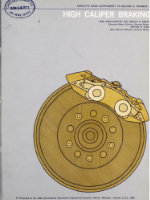 Left: High Caliper Braking is a technical paper released by GM and authored by Zora Arkus-Duntov, Arnold R. Brown and Arthur R. Shaw. It is a fascinating scientific / engineering look at how and why disc brakes came to the Corvette in 1965. The introduction, by Zora Arkus-Duntov, is interesting as Zora defends the use of drum brakes in the Corvette.
Left: High Caliper Braking is a technical paper released by GM and authored by Zora Arkus-Duntov, Arnold R. Brown and Arthur R. Shaw. It is a fascinating scientific / engineering look at how and why disc brakes came to the Corvette in 1965. The introduction, by Zora Arkus-Duntov, is interesting as Zora defends the use of drum brakes in the Corvette.
New Kid In Town: Big Block Debut
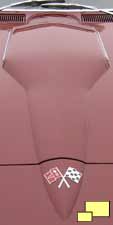 A new Corvette era was ushered in when a leading edge class of engine, fondly known as the "Big Block" was introduced late in the 1965 model year. At the time a huge horsepower race was taking place industry wide and the 396 cu. in. Turbo-Jet was the Corvette's ticket to the party. Rated at 425 hp, it furthered the Corvettes' Bad-Boy reputation. It also represented the first time a Corvette motor was rated at over 400 hp.
A new Corvette era was ushered in when a leading edge class of engine, fondly known as the "Big Block" was introduced late in the 1965 model year. At the time a huge horsepower race was taking place industry wide and the 396 cu. in. Turbo-Jet was the Corvette's ticket to the party. Rated at 425 hp, it furthered the Corvettes' Bad-Boy reputation. It also represented the first time a Corvette motor was rated at over 400 hp.
A new hood was required to clear the massive motor and a handsome new "bubble hood" design (above and left) was introduced. Below: Functional vents in the side nicely broke up the area. Indications are that due to supply problems at the time, a number of small block Corvettes left the factory with the big block hood.
The physically much bigger engine required an enhanced cooling system. There was another drawback; approximately 150 lbs. of added weight, all of it on the front wheels. The weight distribution changed to 51% front / 49% rear, a handling disadvantage compared to the better balanced small block alternative.
1965 Corvette: Fuel Injection Swan Song
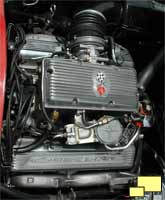 A close examination of the specifications and the options list reveals an interesting fact that makes the 1965 Stingray particularly interesting to car collectors. 1965 was both the first year for all wheel disc brakes and the last year for the fuel injected engine. The two magic performance features would not appear together until 17 years later in the 1982 Corvette. In 1965, fuel injection cost an extra $538.00, adding over 13% to the price of a convertible. The 396 cu. in. motor added only $292.70 to the bottom line yet was rated at 425 hp; 50 more than the fuelie. With the fuel injection system's reputation for complexity and maintenance requirements well known, the days were numbered for the option that first shook the automotive high performance world in 1957.
A close examination of the specifications and the options list reveals an interesting fact that makes the 1965 Stingray particularly interesting to car collectors. 1965 was both the first year for all wheel disc brakes and the last year for the fuel injected engine. The two magic performance features would not appear together until 17 years later in the 1982 Corvette. In 1965, fuel injection cost an extra $538.00, adding over 13% to the price of a convertible. The 396 cu. in. motor added only $292.70 to the bottom line yet was rated at 425 hp; 50 more than the fuelie. With the fuel injection system's reputation for complexity and maintenance requirements well known, the days were numbered for the option that first shook the automotive high performance world in 1957.
1965 Corvette Options, Prices
| RPO | Description | Production | Price |
| Genuine Leather Seats | 2,128 (9.03%) | $80.70 | |
| A01 | Soft Ray Tinted Glass, all windows | 8,752 (37.14%) | $16.00 |
| A02 | Soft Ray Tinted Glass, windshield | 7,624 (32.35%) | $10.80 |
| A31 | Power Windows | 3,809 (16.16%) | $59.20 |
| C07 | Auxiliary Hardtop (for convertible) | 7,787 (33.05%) | $236.75 |
| C48 | Heater and Defroster Deletion (credit) | 39 (0.17%) | n/a |
| C60 | Air Conditioning | 2,423 (10.28%) | $421.80 |
| F40 | Special Front and Rear Suspension | 975 (4.14%) | $37.70 |
| G81 | Positraction Rear Axle, all ratios | 19,965 (84.73%) | $43.05 |
| G91 | Special Highway Axle, 3.08:1 ratio | 1,886 (8.00%) | $2.20 |
| J50 | Power Brakes | 19,965 (84.73%) | $43.05 |
| J61 | Drum Brakes (substitution credit) | 316 (1.34%) | n/a |
| K66 | Transistor Ignition System | 3,686 (15.64%) | $75.35 |
| L75 | 327 cu. in. 300hp Engine | 8,358 (35.47%) | $53.80 |
| L76 | 327 cu. in. 365hp Engine | 5,011 (21.27%) | $129.15 |
| L78 | 396 cu. in. 425hp Engine | 2,157 (9.15%) | $292.70 |
| L79 | 327 cu. in. 350hp Engine | 4,716 (20.01%) | $107.60 |
| L84 | 327 cu. in. 375hp Engine (fuel injection) | 771 (3.27%) | $538.00 |
| M20 | 4-Speed Manual Transmission | 21,107 (89.57%) | $188.30 |
| M35 | Powerglide Automatic Transmission | 2,021 (8.58%) | $199.10 |
| N03 | 36 Gallon Fuel Tank (Coupe only) | 41 (0.17%) | $202.30 |
| N11 | Off Road Exhaust System | 2,468 (10.47%) | $37.70 |
| N14 | Side Mount Exhaust System | 759 (3.22%) | $134.50 |
| N32 | Teakwood Steering Wheel | 2,259 (9.59%) | $48.45 |
| N36 | Telescopic Steering Column | 3,917 (16.62%) | $43.05 |
| N40 | Power Steering | 3,236 (13.73%) | $96.85 |
| P48 | Cast Aluminum Knock-Off Wheels (5) | 1,116 (4.74%) | $322.80 |
| P91 | Blackwall Tires, 7.75x15 (nylon cord) | 168 (0.71%) | $15.70 |
| P92 | Whitewall Tires, 7.75x1 (rayon cord) | 19,300 (81.90%) | $31.85 |
| T01 | Goldwall Tires, 7.75x15 (nylon cord) | 989 (4.20%) | $50.05 |
| U69 | AM-FM Radio | 22,113 (93.84%) | $203.40 |
| Z01 | Comfort and Convenience Group | 15,397 (65.34%) | $16.15 |
|
Total Production:
23,564
Notes: Base Corvette Coupe with 327 cu. in. 250 hp engine and three speed manual transmission: $4,321.00. |
|||
Colors
| Code | Exterior | Quantity | Interior | Soft Top | Wheels |
| AA | Tuxedo Black | 1,191 (5.05%) | Black / Blue / Green / Maroon / Red / Saddle / Silver / White | Black / White / Beige | Black |
| CC | Ermine White | 2,216 (9.40%) | Black / Blue / Green / Maroon / Red / Saddle / Silver / White | Black / White / Beige | Black |
| FF | Nassau Blue | 6,022 (25.56%) | Black / Blue / White | Black / White / Beige | Black |
| GG | Glen Green | 3,782 (16.05%) | Black / Green / Saddle / White | Black / White / Beige | Black |
| MM | Milano Maroon | 2,831 (12.01%) | Black / Red / Maroon / Saddle / White | Black / White / Beige | Black |
| Silver Pearl | 2,552 (10.83%) | Black / Red / Silver | Black / White / Beige | Black | |
| UU | Rally Red | 3,688 (15.65%) | Black / Red / White | Black / White / Beige | Black |
| XX | Goldwood Yellow | 1,275 (5.41%) | Black / White | Black / White / Beige | Black |




